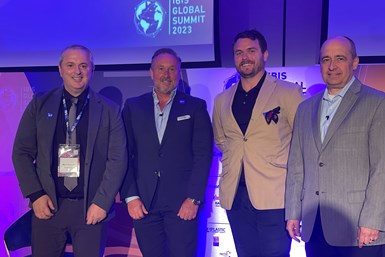Würth CEO Joins 3D Printing in Auto Collision Task Force
The task force will evaluate how 3D printed auto parts can be used to assist in the collision and automotive repair sector in a safe and regulated environment.
Share
(left to right) Mario Dimovski, Boyd Group; Jason Mosely, IBIS Global; AJ Strandquist, Würth Additve Group; and Harold Sears, Imagine Additive Consulting. Photo Credit: Würth Additve Group
Würth Additive Group CEO AJ Strandquist is joining the 3D Printing in Auto Collision Task Force, which recently launched during the International Bodyshop Industry Symposium (IBIS) USA 2023 trade conference in Nashville, Tennessee.
At the conference, IBIS Worldwide announced it was launching an industry-first 3D Printing in Auto Repair Task Force to be led by Harold Sears, owner/president of Imagine Additive Consulting. Sears will drive the task force efforts utilizing his more than 30 years of industry experience, includes leading Ford Motor 3D Printing Solutions for over two decades.
IBIS Global has facilitated a platform in collaboration with its supporting partners to launch the task force. The group will evaluate how 3D printed auto parts can be used to assist in the collision and automotive repair sector in a safe and regulated environment. This strategic partnership aims to drive innovation and facilitate the integration of 3D printing technology within the automotive repair industry.
By joining the task force and collaborating with the other members, Würth Additive seeks to advance the adoption of 3D printing, ultimately revolutionizing collision repair processes and enabling the use of 3D printed parts via Würth’s advanced digital inventory management program called DIS3DP.
3D printing technology enables collision repair professionals to produce complex parts on demand, reduce lead times and enhance repair accuracy. 3D-printed parts can also minimize waste, streamline inventory management and contribute to a more sustainable automotive repair ecosystem.
“I am honored to be included in the groundbreaking initiatives of this task force and for the future collaboration of this thought leadership,” Strandquist says. “I appreciate the Würth organization for supporting the vision of digital infrastructure, and Würth Additive’s unwavering commitment to these efforts. I look forward to working with my new colleagues on the task force to take the next steps in implementing additive manufacturing best practices, integrating digital inventory management solutions, and helping to shape the transformation of the automotive repair industry through the innovations of 3D printing.”
- Watch this episode of The Cool Parts Show to learn how Ford is thinking about additive manufacturing. Led by Harold Sears, Ford’s additive group began 3D printing the parking brake bracket on the Mustang Shelby GT500 instead of stamping it.
Related Content
-
Do Distributors Dream of Digital Inventory? Würth Additive Group Does
It’s more than a dream for Würth Additive Group and its parent company, in fact. Along with supplying additive equipment, the group is now developing solutions for sourcing 3D printed parts in a reliable, elastic digital inventory model.
-
What Holds AM Back in Automotive Production? GM Additive Lead Describes Advances Needed
“If AM were cheaper, we would be doing more of it,” says GM’s Paul Wolcott. Various important factors relate to cost. However, the driving factor affecting cost is speed.
-
BMW Expands Use of Additive Manufacturing to Foster Production Innovations
The BMW Group is manufacturing many work aids and tools for its own production system using various 3D printing processes, with items such as tailor-made orthoses for employees, teaching and production aids, and large, weight-optimized robot grippers, which are used for such things as carbon fiber-reinforced polymer roofs and entire floor assemblies.















